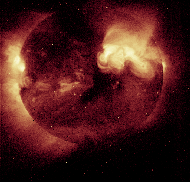My MIT Past
I graduated in 1996 from MIT with a
Bachelor of Science in Physics
(course 8).
I'm also crazy enough to have double majored in Earth, Atmospheric, and Planetary
Sciences (course 12). I was in it for the planetary science
part.
My humanities concentration was in anthropology.
Speaking of classes (well, sort of), take a look at the quotes by professors I've compiled.
MIT Concert Choir
While at MIT, I was involved in a couple
activities that were very important to me. First and foremost, I was
a member of the MIT Concert Choir. The official
Concert Choir homepage includes our past reviews in the Tech, the
MIT student newspaper. During my last term we sang "Cantata 118" by
Bach and Mozart's "Requiem", accompanied by the MIT Symphony
Orchestra.
I have also been a member of Concert Choir for
performances of these compositions:
- Haydn's "Mass in D Minor"
- Vaughan Williams' "Dona Nobis Pacem"
- Brahms' "Requiem" (Accompanied by the MIT Symphony Orchestra)
- Haydn's "The Creation"
- Verdi's "Requiem" (Accompanied by the MIT Symphony Orchestra)
- Bach's "Mass in B Minor"
- Beethoven's "Mass in C"
- Mendelssohn's "Die erste Walpurgisnacht"
- Stravinsky's "Las Noces"
Concert choir did take up quite a bit of time, but it was
definitely worth it... I really miss it.
LSC
The other major activity I was involved in while at MIT
and for three years while I was at BU is LSC. LSC shows
current movies and classic movies to the MIT community. They also try
to bring interesting lecturers to speak on the MIT campus, but since
important people are very expensive these days, they haven't done that
much recently.
Since the fall of 1993 I was a projectionist, but in the summer of
1994 I became a projection subdirector. (I'm actually a licensed
projectionist!) I may have been one of those people you LOVE to yell
at when a movie gets messed up... My last term on LSC was Spring
1999. I still occasionally dream of projectors. :)

Undergraduate Thesis
The spring of my
senior year I again worked for credit in the Earth, Atmospheric, and
Planetary Science department for Professor Elliot as I did last fall,
but this time I did my joint Physics and EAPS thesis. I calculated
the separation in arc seconds of two stars that were occulted by
Neptune's moon Triton in August 1995. I used a Hubble Space Telescope
Faint Object Spectrograph image to find the separation.
Unfortunately, the Faint Object Spectrograph was not really intended
for astrometry, so my calculation did not seem very accurate. It also
did not agree with the separation between the stars that was found
using data from the occultation.
Summer 1995 UROP
In the summer of 1995 I also worked in the
Earth, Atmospheric, and Planetary Science department for Professor
Elliot. I worked on the data analysis of the occultation of a star by
Triton, Neptune's largest moon.
I also got some practical observing experience working with telescopes
at the Wallace Astrophysical
Observatory, near Haystack
Observatory. I helped adjust the polar alignment of the 14"
Cassegrain telescopes so that the tracking would be more accurate. I
also helped calibrate the spectrograph and make sure the image of the
spectra was aligned correctly. A coworker and I used data taken by
the spectrograph to calculate the dispersion of the spectrograph and
to calibrate it even more.
Fall 1994 UROP
During the fall of 1994 I did a UROP for
credit in the Earth, Atmospheric, and Planetary Sciences department.
I needed a planetary science UROP for my minor, but with my new double
major, I could really use the units.
For the UROP I reduced the noise in some infrared data taken during an
occultation of a star by the comet Chiron. This infrared data, along
with already analyzed optical data, will help determine the structure
of Chiron.
Summer 1994 UROP
In the summer of 1994 I had a UROP with the X-ray Timing Explorer (XTE)
satellite project in the Center for
Space Research. The XTE satellite is being built partly at MIT,
UCSD, GSFC, and NASA. The satellite will be in Earth orbit for
several years and will be used to detect distant cosmic x-ray sources
that would not be detectable from Earth's surface. The satellite was
just launched on December 30, 1995. I was pretty much a grunge worker
in the project, but I helped quite a bit with calibration of the
flight detectors and the analysis of the calibration data. I also got
to play with a six-foot x-ray generator. : ) I really enjoyed this
UROP.
Back to my homepage.
avondale@astro.umd.edu

